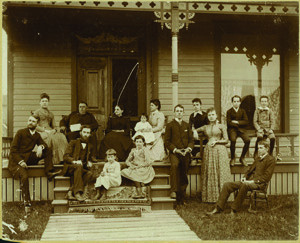Marriage has changed more in the last 30 years than in the previous 3,000.
For millennia, marriage decisions were dictated more by economic and political considerations than by love and personal satisfaction. This made marriage a very coercive institution, especially for young people and for women in general. Today, by contrast, people have unprecedented freedom about whether, when, and whom to marry, as well as about how to organize their personal relationships in and out of marriage. Marriages are no longer based on the legal subordination of women and children, and many women have even attained economic equality with their partners.
 © H. Armstrong Roberts/Corbis
© H. Armstrong Roberts/Corbis
But like all democratic revolutions, the transformation of marriage and family life has been messy. More choices mean new opportunities for success, but also new opportunities for failures, and new temptations to reach beyond one’s grasp. We have solved many old problems, but in the process created some new ones. For example, on average, parents invest more emotional energy and financial resources in their children than ever before, but children whose parents cannot or will not make such investments face new vulnerabilities. Young people have greater mobility and personal freedom than in the past, but their independence can turn into isolation after they become parents.
Similarly, the things that have made marriage more fulfilling have made it more brittle. Because couples expect so much more love, intimacy, and mutuality from marriage, they work harder to live up to their ideals—but when marriage doesn’t meet their high expectations, they can be quick to divorce.
Family history is full of examples of such trade-offs: For thousands of years, the flip side of a strong institution of marriage was the equally strong and tremendously unjust institution of illegitimacy, which allowed families to turn their backs on any children born to a relationship not sanctioned by one’s parents and community. Hundreds of thousands, if not millions, of such babies were abandoned, often to death, over the centuries. Abolishing harsh penalties for illegitimacy was a world-historic gain. But it also allowed some men to refuse marriage if a partner became pregnant because having their child out of wedlock no longer carried such severe consequences. At the same time, many young women have underestimated how hard it is to raise a child without the support of a partner.
 Over the last 100 years, the American family has gotten more diverse and egalitarian, but also smaller and more isolated.
© Tomas Van Houltryve/Corbis
Over the last 100 years, the American family has gotten more diverse and egalitarian, but also smaller and more isolated.
© Tomas Van Houltryve/Corbis
We need to address the new challenges raised by the transformation and diversification of marriage and family life. But we cannot do so if we delude ourselves into thinking there has ever been a Golden Age when life was much better for all, or even most, families. Instead, we must build on the very real gains we’ve made while recognizing the new dilemmas we face—dilemmas that require policy solutions as well as individual effort.
Real traditional marriage
Sometimes people romanticize marriages of the past. In fact, the personal relationship between husband and wife did not count for much in traditional marriage. Instead, the economic and political interests of the couple’s parents or community were paramount. In the upper classes, people married to acquire influential in-laws, forge business deals, or even conclude peace treaties. In the middle classes, men looked for wives who would bring a handsome dowry at marriage. Women married for social respectability and future financial security. Farmers and artisans could not survive without a “yoke mate,” so a strong arm and good work ethic outweighed more sentimental considerations.
 © Minnesota Historical Society
© Minnesota Historical Society
Under these circumstances, it was considered irresponsible to let young people freely choose their own mates on such a self-indulgent basis as love. And once married, couples were not expected to construct a relationship that fostered mutual cooperation, but to conform to a rigid marital model based on male dominance and wifely subordination. “Husband and wife are one,” said traditional English common law, “and that one is the husband.”
It was only 200 years ago that Western Europeans and Americans began to believe that young people had the right to choose their own mates, and that they should do so on the basis of love and mutual attraction. It was only 150 years ago that laws began to give wives equal property rights over money they inherited or earned, and just 120 years ago that courts ruled that a husband had no right to physically “correct” or imprison his wife. Adultery, once accepted as normal for husbands, became less acceptable. Wife-beating was increasingly condemned, although it was seldom treated as a serious offense until after the second wave of feminism in the 1970s.
But well into the 20th century, couples did not have to work hard at negotiating their relationships because law and social custom required wives to give in to their husbands’ wishes. In the 1950s, marital advice books invariably told women to play dumb, act helpless, and let their husband be “the boss.” As late as the 1970s, many states had “head and master” laws that gave husbands the final say over such decisions as what should be done with community property, where the couple should live, and whether the wife could take a job. Marital rape was seen as a contradiction in terms, because it was considered a wife’s duty to have sex whenever her husband wanted it. And women’s economic dependence remained so pervasive that most women had to marry as much for practicality as for love, and had little option to leave an unfair, unsatisfactory marriage.
A new family landscape
All this changed with the economic and political reforms and the civil rights climate of the 1960s and 1970s. The new independence of women and the new personal freedoms of youth enabled men and women to form healthier relationships and build more successful lives as singles. These changes also enabled same-sex couples to come out of the closet. But in the 1970s and 1980s, we saw a lot of turmoil as people struggled to adapt to these changes, especially as they dealt with a sharp economic downturn after 1973.
In the 1990s, family indicators improved. Today divorce rates are down from their peak in the 1970s, especially for college-educated couples. Teen births are at new lows. As of 2000—although there have been setbacks since then—juvenile crime was lower than at any time since 1966. And the pace of family change has slowed, suggesting that predictions of the death of marriage were overwrought.
But we must recognize that alternatives to marriage are here to stay. Women’s economic independence—combined with the expansion of consumer products that reduce the need for a full-time housewife, and the decline in society’s coercive power over personal life—means divorce will not disappear. The rising age of marriage is a promising sign for many marriages since it is associated with greater family stability, but it also means that women have a longer period of life in which they can end up as unwed mothers, either by choice or by chance. The majority of Americans, same-sex or opposite-sex, live together outside of marriage for a portion of their lives, and not all these relationships result in marriage. We may be able to create more healthy marriages in the future, but we can never again assume that all dependents, young or old, will be taken care of within first-marriage nuclear families.
Even married-couple families face new challenges. The majority of mothers of children over age one are in the workforce, and contrary to periodic claims that mothers are “opting out,” several studies show that women are much less likely to leave the labor force to stay home with their kids than in the past. The male-breadwinner family is no longer the norm.
In this context, many of our problems arise not because we’ve changed too much but because we haven’t changed enough. One big cause of marital stress and divorce is the failure of some men to change their household roles enough to match the change in women’s work roles. Another cause, researchers are finding, is that couples tend to fall into traditional gender roles after the birth of a child, which can produce resentment in both parents. And one of the main dangers to children after a divorce is the old-fashioned notion of many men that their obligations to their kids end when they no longer enjoy the services and support of the children’s mother.
Initiatives for change
This failure to change enough is not simply an individual problem but a deeply institutional problem as well. Indeed, as individuals, many Americans are adapting remarkably to the changes in marriage and family life. After some initial resistance, most men have begun to share housework and childcare with their partners far more equitably. For example, the Families and Work Institute found that Generation X dads spend an average of 3.4 hours per workday with their children—a significant increase over the average of 2.2 hours that Baby Boomer fathers spent with their kids. Today, 49 percent of couples say they share child care equally, compared with 25 percent in 1985.
Men’s greater involvement at home is good for their relationships with their spouses, and also good for their children. Fathers who are more involved with their families raise sons who are more expressive and empathic and daughters who are more likely to do well in school—especially in math and science.
Meanwhile, working moms have increased the time they spend with their children even as they have increased their hours on the job. According to a recent study by Suzanne Bianchi, John Robinson, and Melissa Milkie, both mothers and fathers spend more time interacting with their children today than they did in 1965, at the height of the male-breadwinner/female-homemaker family. Single mothers have less time to spend with their families than married mothers, but they too have significantly increased their time with children.
Even childless and unmarried individuals are doing immense amounts of family work, with one in four American workers spending seven hours or more each week caring for an aging parent. In fact, Naomi Gerstel of the University of Massachusetts and Natalia Sarkisian of Boston College find that childless single individuals give more time and practical support to parents, kin, and friends than married couples do.
The right question today is not, “How can we shoehorn everybody into a single perfect family form?” Instead, it is, “How can we help every type of family—whether living in the same household or not—minimize its particular weaknesses and build upon its potential strengths?” And this is where our social institutions and political leaders need to step up to the plate. Three initiatives seem especially important.
The first is to reverse the trend toward widening income inequality, which makes it more difficult for poor families to enter and sustain marriages, and more difficult for single parents to raise their children in ways that can break the cycle of poverty and relationship instability. Possibilities here include increasing the minimum wage, which has fallen to its lowest inflation-adjusted level in two decades; investing in job creation programs; improving the resources of schools in our poor communities; and expanding the Earned Income Tax credit.
Another imperative is to develop family-friendly work policies that are not just reserved for highly paid, highly skilled workers but are guaranteed to all workers through federal regulation. Of the 20 richest nations in the world, all but the United States and Australia offer subsidized maternity or parental leave. In Australia, workers are entitled to a year off, though it is without pay. Here, by contrast, the Family Medical Leave Act (FMLA) offers workers who qualify (only about half the workforce) a measly six weeks without pay. Researchers Jody Heymann, Alison Earle, and Jeffrey Hayes of McGill and Harvard Universities report that 107 other countries in the world protect working women’s right to breastfeed on the job; 137 countries mandate paid annual leave, with 121 of these countries guaranteeing two weeks or more each year; 134 have laws that fix the maximum length of the work week; 49 guarantee leave for major family events, such as marriages or funerals; and 145 countries provide paid leave for short- or long-term illnesses. The U.S. does not offer any of these guarantees.
Researcher Janet Gornick of Baruch College at the City University of New York notes that public policy in most of Europe ensures the affordability and availability of early childhood education and child care. In Belgium, France, and Italy, nearly all children are enrolled in full-day, quality preschools from the age of three until they begin primary school. The Scandinavian countries offer a combination of paid parental leave and publicly financed child care for toddlers. In the U.S., by contrast, only one of every seven children eligible for a public child-care subsidy actually receives it. Our child care is unregulated, unevenly available, and underfunded. That needs to change.
Finally, we need to stop acting as if heterosexual marriage is the only place where people incur long-term obligations. Single parents, cohabiting couples, gay and lesbian families, and divorced parents are now a permanent part of the picture. They, too, need support systems to help them meet their responsibilities in healthy ways, along with clear-cut rules to prevent abuse or blatant unfairness when relationships end. Divorced and unwed parents, for example, need constructive advice on effective parenting. Young people need tested programs to help them develop the resistance skills to say no to pressured sex and the coping skills to handle their sex lives responsibly once they begin consensual relationships, in or out of marriage. It is not enough nowadays to educate people for marriage; we must also educate them for non-marriage.
New social institutions, economic trends, and cultural attitudes pose many challenges to families today. Yet we can find encouragement in the progress we have made so far in democratizing family life and making marriage a more just and compassionate institution. So long as we face new challenges squarely, instead of longing for a largely mythical and in any case irrecoverable past, we can approach the future with hope rather than despair.



Comments